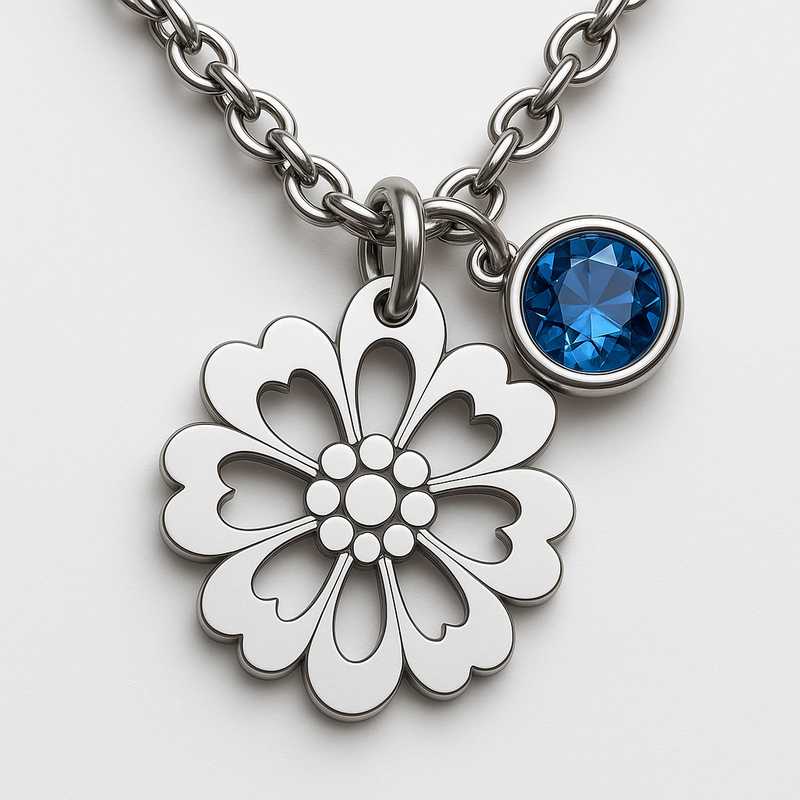Advanced Materials & Technologies: Custom Birth Month Charm Necklaces

Introduction: Rethinking Jewelry Manufacturing for Modern Demands
In the high-stakes world of B2B jewelry manufacturing, materials and technology are no longer just behind-the-scenes players—they’re front and center. When creating custom birth month charm necklaces, especially those integrating floral and birthstone elements, the spotlight naturally falls on durability, aesthetics, sustainability, and precision. That’s where stainless steel, particularly grades 304 and 316L, shines. But it’s not just about choosing the right metal—modern techniques like laser cutting, hydraulic forming, and advanced corrosion treatments push boundaries, while eco-friendly practices are increasingly becoming industry standard. This page explores the sophisticated material science and production innovations behind high-quality, sustainable OEM/ODM stainless steel jewelry for discerning clients.
304 vs 316L Stainless Steel: Corrosion Resistance & Practical Applications
Understanding material behavior under various conditions is critical when manufacturing jewelry designed for daily wear. 304 and 316L are the most popular stainless steel alloys used in jewelry—but they’re far from interchangeable.
304 stainless steel contains approximately 18% chromium and 8% nickel. It’s widely used due to its strong corrosion resistance, affordability, and aesthetic polish. However, in high-moisture or saline environments—like tropical climates or coastal regions—304 can show signs of pitting over time.
316L stainless steel, often labeled as “marine grade,” takes it up a notch. Its added molybdenum content (~2–3%) dramatically improves resistance to chlorides and acids. It’s also hypoallergenic, making it ideal for consumers with skin sensitivities.
OEM/ODM Usage Scenarios:
- 304 Stainless Steel: Best for indoor wear collections, low-sweat climates, or budget-conscious seasonal product lines.
- 316L Stainless Steel: Recommended for high-end, luxury lines, or outdoor-heavy lifestyles—think coastal fashion retailers or year-round gifting catalogs.
Choosing between the two isn’t just a budget decision—it’s a brand promise. Offering both as customizable options lets OEM clients scale collections across multiple customer segments.
Precision Engineering: Laser Cutting & Hydraulic Forming
Modern charm necklaces aren’t just sculpted—they’re engineered. High-precision manufacturing techniques play a pivotal role in turning raw stainless steel into intricately shaped charms that retain both visual delicacy and structural integrity.
Laser Cutting Technology
Laser cutting allows for flawlessly intricate flower petals and gemstone bezels at micron-level precision. The use of fiber lasers ensures clean edges and minimal heat distortion, which is essential for maintaining the polished finish of the stainless steel surface. For OEM/ODM production, it translates into batch consistency and reduced post-processing time.
Hydraulic Forming Applications
Using hydraulic presses enables three-dimensional shaping of metal components without over-stressing the material. This is particularly beneficial when crafting curved petals or domed settings for birthstones. The hydraulic process guarantees high repeatability, crucial for OEM clients seeking volume without variance.
Pairing both techniques ensures that even complex design specifications from international brands can be met swiftly and cost-effectively.
Corrosion Pattern Treatments: Beauty Meets Function
Beyond preventing rust, corrosion treatments can also be aesthetic tools. Advanced surface engineering allows manufacturers to create controlled oxidation patterns or apply passivation to enhance color vibrancy and texture.
Common Techniques Include:
- Electrochemical Polishing: Removes microscopic peaks for a mirror-like finish, reducing surface area prone to corrosion.
- Black Oxide Coating: Applied via chemical treatment to create sleek, matte finishes ideal for masculine collections or modern minimalist lines.
- Laser Etching: Used to add permanent custom messages, brand logos, or serial numbers—perfect for traceability in OEM production.
With birth month necklaces, especially those combining floral and gem-like details, corrosion design elements help achieve both decorative value and practical longevity.
Sustainable Jewelry Manufacturing: Eco-Friendly from Start to Finish
Today’s jewelry customers—and by extension, B2B clients—expect more than just aesthetics. Eco-conscious production is no longer a trend; it’s an expectation. Here’s how advanced stainless steel charm manufacturing aligns with sustainability goals:
Recycled Materials
High-grade 304 and 316L stainless steel can be sourced with up to 60% recycled content. Manufacturers working with certified suppliers can reduce environmental impact while still guaranteeing material purity.
Green Electroplating
Traditional electroplating involves heavy metals and wastewater discharge. Modern facilities are shifting to trivalent chromium baths and closed-loop filtration systems that reduce chemical exposure and waste.
Wastewater Recycling & Metal Recovery
Implementing microfiltration and ion exchange systems enables water reuse and recovery of valuable metals from waste. This leads to cost savings and compliance with tightening global regulations.
Energy Efficiency
From low-power fiber lasers to automated heat-treatment furnaces, smart factories are now optimizing production with reduced carbon footprints—ideal for B2B clients seeking to align with ESG targets.
Certifications & Compliance
Leading OEM/ODM providers now offer REACH, RoHS, and ISO14001-certified production lines. These third-party verifications offer assurance to retailers and wholesalers targeting green-conscious consumers.
These environmentally friendly practices not only improve your brand’s sustainability narrative but also future-proof your product pipeline against evolving regulatory landscapes.
Case Study: OEM Success Story from Coastal Europe
A European jewelry brand, catering to Mediterranean boutiques, approached a stainless steel OEM partner for a line of summer-themed birth month flower necklaces. Priorities included corrosion resistance, sustainability certification, and on-brand floral etching.
Solution Highlights:
- Material: 316L stainless steel selected for superior seawater resistance.
- Production: Laser cutting used for petal detailing; hydraulic forming shaped the bezels for heat-set glass birthstones.
- Finishing: Electrochemical polishing and green electroplating used to ensure a bright finish without toxic by-products.
- Result: Over 120,000 units produced with zero corrosion returns over 18 months. Brand reported 19% lift in eco-conscious customer engagement.
This case underscores the value of marrying technology and sustainability in B2B stainless steel jewelry manufacturing.
Conclusion: Elevate Your Brand with Smart Manufacturing
Modern birth month charm necklaces are more than just adornments—they’re microcosms of material innovation, precision engineering, and ecological awareness. For B2B buyers seeking dependable OEM/ODM partners, the difference lies in the details: choosing the right alloy, integrating cutting-edge fabrication, and committing to sustainability from sourcing to shipping.
Ready to create next-gen custom stainless steel jewelry? Our team specializes in delivering end-to-end solutions tailored to your brand’s vision and values. Contact us today to explore how our advanced materials and green technologies can bring your jewelry lines to life—beautifully, responsibly, and reliably.
